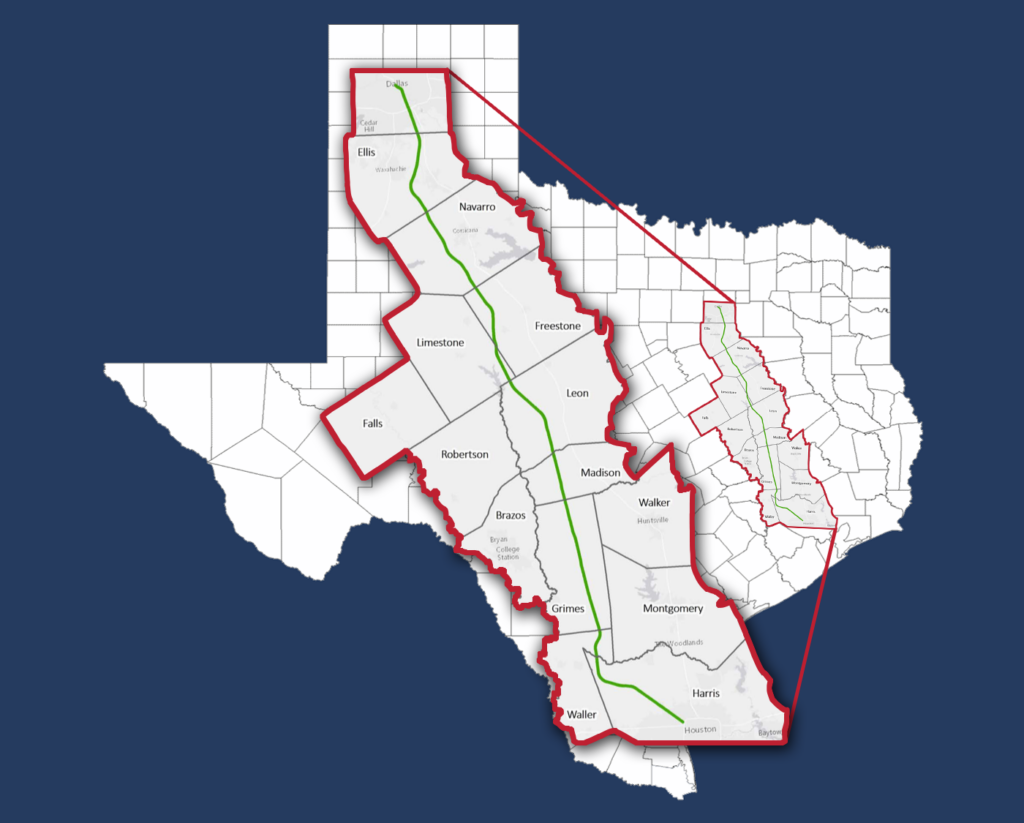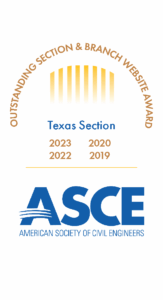Highspeed Rail Issue
Author: Mustafa Haque S.M.ASCE
September 2024
The high-speed rail line between Houston and Dallas promises to significantly reduce travel time, offering a faster and more convenient alternative to car travel and carbon-intensive short flights. This improvement in travel efficiency is expected to boost regional connectivity and stimulate economic growth by facilitating business travel, tourism, and daily commutes. High-speed rail is a more sustainable transportation option, potentially reducing carbon emissions and contributing to climate change mitigation efforts. For the high-speed rail to be fully accepted by the public and effective in its mission, Houston and Dallas-Fort Worth (DFW) must improve walkability and public transit.
Amtrak is currently in the exploration phase of the project. They’re currently partnering with Texas Central for the Houston-Dallas high-speed rail project, using a federal grant of $500,000, which will continue for about 18 months. As of June 2024, 30% of the necessary land has been acquired. Despite broad political support, securing additional private funding remains a challenge. However, Amtrak views the route as the most feasible for high-speed rail in the U.S. due to its large, growing population and favorable topography. They’ve also released promotional materials to showcase the project’s benefits. To have a better chance of securing private funding, the Municipalities of Houston and the DFW metroplex should consider improving walkability and public transit to make the high-speed rail project more acceptable.

The LGV Est high-speed rail network, located in France, demonstrates the efficiency and value of integrating high-speed rail with local public transit, which is highly relevant considering the renewed interest in the proposed Houston-Dallas high-speed rail. Connecting major stations like Gare de l’Est in Paris to cities such as Nancy-Ville and Dijon-Ville, the LGV Est enhances accessibility by linking high-speed rail with extensive local transit options, including regional trains, metro lines, and bus services. This model ensures that passengers can seamlessly transition from local public transit to high-speed rail, much like what is envisioned for Houston and Dallas. For example, Gare de l’Est functions as a crucial hub with robust connections to local transport, enabling a smooth start for high-speed journeys, which could serve as an inspiration for the development of integrated transit hubs in Houston and Dallas. Similarly, the integration seen at Nancy-Ville and Dijon-Ville could guide the development of effective regional connectivity in Texas. The LGV Est example illustrates how comprehensive connectivity can enhance travel experiences by reducing travel time and improving accessibility, aligning closely with the goals of making high-speed rail a practical and integrated solution for daily commuting in the Houston-Dallas corridor.

Reducing reliance on automobiles should be a primary objective for engineers and city planners to ensure the high-speed rail between Houston and Dallas achieves its full potential. By creating robust, accessible public transit systems and enhancing walkability within the cities, travelers can easily navigate their destinations without needing cars. This can include expanding light rail networks, improving bus services, and developing pedestrian-friendly infrastructure. Such measures will make the high-speed rail more appealing by providing seamless connectivity and promoting a sustainable urban environment, reducing traffic congestion and lowering carbon emissions. Emphasizing low automobile reliance will ensure that high-speed rail is a truly integrated and efficient part of the region’s transportation ecosystem.
Transportation planners in Dallas and Houston should prioritize improving pedestrian safety, reducing investments in car-reliant infrastructure, and promoting high-quality pedestrian infrastructure. With current walk scores in the 40s, both cities lag significantly behind New York City’s walk score of 88 and even more far behind Paris, which has a walk score of 100/100. Planners can create more walkable urban environments by focusing on safer crosswalks, wider sidewalks, and more pedestrian-friendly areas. This shift will enhance the high-speed rail project’s appeal and contribute to a healthier, more sustainable urban lifestyle, reducing the overall dependence on cars and making the high-speed rail more attractive to travelers who won’t have a car in their destination.
To complement the goals of the high-speed rail project, prioritizing multi-use, high-density development in both the DFW metroplex and Houston is essential. These metropolitan areas are currently characterized by sprawling, car-dependent landscapes that hinder the effectiveness of public transportation initiatives. High-density development fosters a more sustainable urban environment by encouraging the efficient use of land and resources, reducing the need for long car commutes, and supporting vibrant, walkable communities. By concentrating residential, commercial, and recreational spaces within closer proximity, cities can enhance the convenience and accessibility of public transit, making it a viable alternative to car travel. This strategy will improve the high-speed rail system’s functionality and contribute to the overall livability and environmental sustainability of the metropolitan regions.
But if planners and politicians truly want to make the highspeed rail project worthwhile, officials in Houston and Dallas should improve the Metro and DART systems respectively.
Dallas Area Rapid Transit (DART) currently grapples with issues such as poorly maintained stations, homelessness on trains, and infrequent service in certain areas. Although there are plans for improvement, a significant concern arises from Dallas City Council members Cara Mendelsohn, Adam Bazaldua, Gay Donnell Willis, and Omar Narvaez proposing to reduce the city’s sales tax contribution to DART from 1% to 0.75% to address a $3 billion pension fund deficit. This reduction could undermine DART’s ability to mitigate road congestion and serve residents without vehicles, which is crucial for supporting the high-speed rail project’s connectivity. Given Dallas’s low transit score of 40, an alternative approach involves reducing parking minimums and promoting urban density through multi-purpose zoning. Such measures would not only enhance the efficiency and appeal of the city’s transit system but also increase sales tax revenue, providing a more sustainable funding model for DART. This strategy aligns with the goals of integrating high-speed rail into a well-connected urban framework, fostering equitable growth, and ensuring robust support for both local and regional transit solutions.
Reducing car dependency in the DFW metroplex and Houston is critical for ensuring the success of the high-speed rail system. Travelers arriving by high-speed rail should be able to continue their journey seamlessly without needing a car. This necessitates significant improvements in public transit infrastructure and urban planning to create walkable, transit-oriented communities. Addressing the unsustainable sprawl of these metropolitan areas is imperative to these goals, as it will facilitate the development of a more connected and efficient transportation network. By focusing on high-density, multi-use development and reducing reliance on automobiles, Dallas and Houston can set a precedent for modern, sustainable urban planning that maximizes the benefits of high-speed rail and promotes a healthier, more sustainable future.
Mustafa Haque S.M.ASCE is currently research assistant at Southern Methodist University
1 https://www.texascentral.com/alignment-maps/
2 https://www.eurail.com/en/plan-your-trip/trip-ideas/trains-europe/high-speed-trains/tgv



